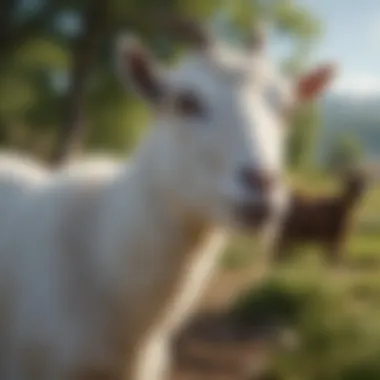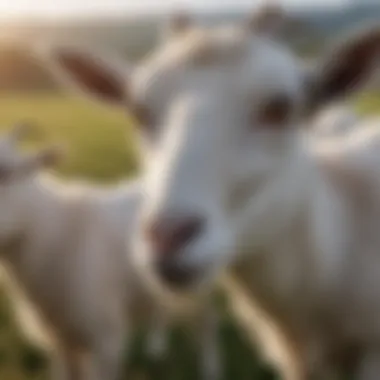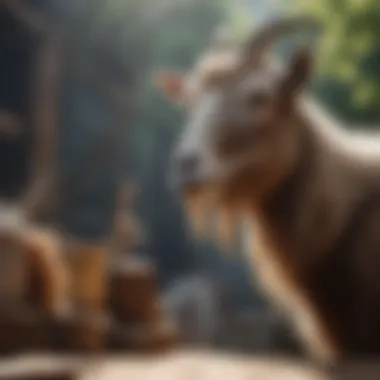Financial Insights on Goat Ownership: Costs Explained


Intro
Owning goats has become increasingly popular among farmers and pet enthusiasts alike. These spirited creatures can provide various benefits, from milk production to land management. However, diving into goat ownership isn't just about the cuteness factor; it's essential to take a careful look at the financial implications. Understanding the costs associated with purchasing goats is an important first step. Factors like breed, age, and geographical location play crucial roles in determining these expenses.
Evaluating the market trends and costs will help potential goat owners make educated decisions that align with their goals. The following sections aim to dissect these financial aspects further, providing insights that ensure both fiscal responsibility and fulfillment in goat ownership.
Cost Factors in Goat Ownership
When considering goat ownership, understanding the various cost factors is crucial. Every little detail adds up, so let's break it down:
Breed
Picking the right breed is foundational. Certain breeds like Nubian or Saanen goats are typically more expensive due to their sought-after traits, such as high milk production and friendly temperament. In contrast, other breeds like Boer might be priced lower but can also provide significant meat production. The breed you choose can have lasting implications for costs associated with feeding, housing, and veterinary care.
Age
Younger goats might come with a lower price tag, but think long-term. Adult goats integrated into a herd may cost more upfront due to their established behaviors and health. Purchasing kids is appealing, but training and raising them is a financial commitment of its own.
Geographical Location
Location impacts pricing significantly. Goats closer to urban areas can cost more due to demand. Some regions have more local breeders, which could help you negotiate better prices. On the flip side, remote areas can present added transport costs, adding another layer to the financial aspect.
Understanding these core factors can save you time and money in the long run.
Beyond the Purchase Price
It's easy to focus solely on the initial purchase cost, but there are additional financial commitments that you should consider:
Daily Maintenance
The ongoing costs for feed, bedding, and general maintenance can accumulate quickly. A quality diet is essential, particularly if you are raising goats for milk or breeding purposes.
Veterinary Care
This is often an overlooked expense. Goats need regular vaccinations and health check-ups to ensure their overall health. Common conditions could lead to high veterinary bills if not monitored properly.
Housing
Goats require sufficient shelter to stay healthy, particularly against harsh weather. Building or purchasing a suitable barn or pen must be part of your financial planning.
Insurance
Some goat owners overlook this aspect, but consider investing in livestock insurance to mitigate potential losses. This can be especially important for established breeders who have a lot on the line.
Making informed financial decisions entails understanding the lifecycle costs of goat ownership. With the right knowledge, potential owners can navigate through the intricacies and risks more effectively.
Ending
As we wrap this up, it's become clear that goat ownership extends far beyond the initial purchase. Careful consideration of breed, age, and location is essential, but equally important are the ongoing costs related to maintenance, healthcare, and housing. Understanding these financial implications will serve as your guide, helping you create a sustainable investment that aligns with your ownership goals.
The path into goat ownership can be rewarding, and by being equipped with the right information, potential owners can step forward with confidence.
Preamble to Goat Ownership
Goat ownership has gained momentum over the years, transforming from a niche hobby to a flourishing venture for many. This shift is not just about the appeal of these lively creatures but also the myriad financial considerations involved. Understanding the economic implications of goat ownership can help you navigate the intricacies of this business, from the initial purchase to ongoing costs.
The Rise of Goat Farming
In recent years, goat farming has seen a significant uptick in popularity. Numerous factors contribute to this surge, including a growing demand for goat meat, milk, and even fiber. The increase in health awareness among consumers has fueled interest in goat as a leaner alternative to beef and pork, making goat meat an attractive option.
Moreover, the versatility of goats makes them suitable for various farming practices, whether you're running a small homestead or engaging in larger-scale agriculture. These animals require less space compared to traditional livestock, and their foraging ability allows them to thrive in less-than-ideal pasture conditions. Additionally, goats are often seen as a sustainable choice, offering an eco-friendly method of land management by grazing on brush and overgrowth.
As goat farming continues to evolve, understanding the dynamics of what drives success financially becomes crucial. Buyers should consider the breed, market trends, and local conditions that can affect both purchase prices and long-term viability.


Why Choose Goats?
Goats aren't just adorable; they bring a wealth of benefits that can positively affect various aspects of farming or even personal enjoyment. First and foremost, they are relatively easy to care for compared to other livestock.
Below are reasons to consider goat ownership:
- Adaptability: Goats can thrive in a range of climates and living conditions, making them a practical livestock choice for many regions.
- Cost-effectiveness: Initial and ongoing costs are often lower relative to other farm animals. Their feed, maintenance, and health needs tend to be manageable for small-scale owners.
- Reproductive viability: Goats reproduce faster than many other livestock, which can lead to increased production over time, enhancing financial returns.
- Product diversity: Depending on the breed, goat owners can enjoy milk, meat, and fiber products, creating multiple income streams.
It's worth noting, however, that while goats can be seen as a reliable source of income, they also require commitment. Adequate shelter, feed, and healthcare are essential. Understanding these needs will guide your investment and ensure that choosing goats aligns with your financial goals.
Understanding Goat Breeds
Getting a grip on the concept of goat breeds is essential for anyone considering goat ownership. Just like dogs or cats, goats come in varied shapes, sizes, and temperaments, which impacts both their suitability for different purposes and their costs. Knowing which breed aligns with your goals can make all the difference, especially when it comes to your finances. Whether you aim to produce milk, meat, or fiber, each breed has its own set of requirements and potential returns. Hence, understanding goat breeds becomes a cornerstone for making informed and practical investment decisions.
Dairy Goat Breeds
When it comes to dairy goats, a handful of breeds frequently stand out: Nubian, Saanen, and Alpine being among the more popular choices.
- Nubians are known for their higher butterfat content in milk, making them a favorite for cheese producers. Their unique vocalizations and affectionate nature add an extra charm.
- Saanens, on the other hand, are the quiet giants of the dairy world; they are usually one of the largest dairy goat breeds and offer a steady supply of milk throughout the year, which appeals to commercial producers.
- Alpines are versatile and adapt well to various climates, often producing milk rich in volume and quality.
From a financial perspective, dairy goats might require significant initial outlay for quality breeding stock, but they can also yield profitable returns through milk and cheese sales.
Meat Goat Breeds
Meat goats, particularly the Boer breed, have gained considerable traction in livestock farming. Known for their rapid weight gain and robust physicality, Boers are often regarded as the gold standard in meat production.
Other breeds worth mentioning include:
- Kiko goats, which have gained popularity for their ability to thrive in less-than-ideal conditions, showcasing resilience alongside growth rates. They are often more economical to raise, which can be a financial boon for new goat owners.
- Spanish goats are also quite hardy and are known for their ability to adapt to various environments, making them a good investment for meat producers in a range of climates.
Given their relative ease of care and quick growth, meat goats can offer a quicker return on investment compared to dairy goats. Knowing this, it's essential to understand the market demand for various meat breeds in your region when considering your purchase.
Fiber Goat Breeds
For those interested in the fiber industry, specific breeds like Angora and Cashmere goats are your best bets.
- Angora goats are famous for their mohair, which is highly sought after in the textile market. However, their care requirements can be more demanding, which translates into potentially higher costs and time invested.
- Cashmere goats produce a luxurious fiber that’s lighter and warmer than regular wool, but they, too, come with their unique set of care needs and market considerations.
Investing in fiber goats can be a bit of a double-edged sword; the returns can be lucrative, but they often require additional investment in processing equipment and marketing your product. Understanding the nuances of each breed can help you gauge whether the financial commitment is worthwhile.
Factors Affecting Goat Prices
Understanding goat prices isn't as straightforward as it might seem. It's more like peeling an onion—each layer reveals something new. The costs involved can fluctuate considerably based on several pivotal factors. Being educated about these elements not only helps potential buyers budget accurately, but it also allows them to identify good deals amidst the chaos of market prices.
Breed Demand and Supply
When it comes to goats, just like any other livestock, the principle of supply and demand reigns supreme. Some breeds are simply more sought after than others. For instance, Nubians, prized for their high milk yield, often fetch a premium price. If you're in an area where dairy farming is booming, you might find prices sky-high.
Conversely, certain breeds, such as the Boer goat, could be cheaper in ranching communities where meat production is standard. Hence, one could say that if you want to climb the goat ladder, pay close attention to what breeds are in vogue in your area. Knowing the local market can be a game changer:
- Popular Breeds: Those that hold high demand can spike prices dramatically.
- Less Known Breeds: Often priced lower but may come with unique benefits, like drought resilience.
Age of the Goat
Age plays a significant role—a young goat might show promise, but it also comes with unpredictable costs for long-term care. Typically, goats range in price from the newborns (kids) to adults. Here's how it generally breaks down:
- Kids: Generally cheaper, great for those who want the experience of raising goats from the ground up.
- Yearlings: Slightly higher in price but often ready to breed.
- Adults: Depending on their health and ability to produce milk or offspring, these can demand the highest prices.
Older goats could be a mixed bag—some have gone through medical issues that could affect their long-term viability. It's wise to consider whether you want to invest early or if an adult goat fits your strategy better. After all, the choice of age can shape your financial commitment down the line.
Health and Certifications
Lastly, let’s not forget health. The well-being of the goat factors heavily into its price tag. Healthy goats with validation through health certifications are generally worth a bit more. Buyers looking for goats with records of vaccinations or genetic testing often find these goats more expensive but less risky in the long run. A few critical points:
- Vaccination Status: A goat with current vaccinations is less likely to incur unexpected veterinary bills.
- Genetic Certifications: For those serious about breeding, knowing the genetic background can raise or lower the price. This info can sometimes tip the scales in your favor when negotiating.


Furthermore, if a seller provides a clean bill of health through a vet, that could spark a surge in demand.
As the market decks its prices based on these variables, understanding how they interconnect equips you with the knowledge necessary to make informed decisions.
In summary, when considering goat purchases, keep these elements in mind. Doing your homework now can save you a soggy bottom later on when those bills roll in.
Regional Pricing Variations
Understanding how goat prices shift based on region is no small potatoes. It's paramount for potential buyers to grasp the intricacies of regional pricing variations. Not only do they impact the overall investment needed to start goat farming, but they also unveil local market dynamics that can shape your budget and expectations. Exploring these price differences can help you plan effectively, while making your goat ownership journey smoother.
Urban vs Rural Pricing
When it comes to purchasing goats, the divide between urban and rural pricing can be as wide as the Grand Canyon. In urban areas, demand for goats often leans towards niche markets like dairy and fiber breeds, which drives up prices. People in cities might seek goats for aesthetics or small-scale farming, leading to higher competition. Therefore, you may find prices are elevated, even for standard breeds.
In contrast, rural settings tend to have a more stable supply of livestock. Farms are in abundance, which can lead to lower prices and a local community that values the agricultural aspect more than the urban, trend-based approach. However, rural buyers should consider transportation costs — getting goats from a local farm might cost less overall than finding them at city prices, but higher travel can chew up those savings quickly.
Some key points to keep in mind when looking at urban vs. rural pricing include:
- Transportation Costs: Evaluate how far you need to go to obtain your goats.
- Breed Popularity: Certain breeds may fetch higher prices in urban settings due to their trendy status.
- Market Saturation: In rural areas, buyers might have access to various local sellers competing for attention.
Local Market Impact
The local market's whims can make or break the goat-buying experience. Factors like local agricultural fairs, the availability of breed experts, and community demand all play a role in shaping prices. If there’s a surge in local interest due to goat yoga classes or sustainable farming workshops, you might see a spike in prices as more folks decide to jump on the goat bandwagon.
On the flip side, if nearby farms are struggling or there’s an oversupply, prices could drop faster than a lead balloon. Each local community has its own dynamics that can influence goat prices, requiring potential buyers to keep an ear to the ground.
When assessing local market impacts, consider the following:
- Recent Developments in Agricultural Trends: If goats gain popularity in your area, prices will likely rise.
- Seasonal Considerations: Look for trends in the spring or summer, when more buyers are hopeful to start new farms.
- Connections to Local Farmers: Having contacts in the community can sometimes lead to better deals that wouldn’t be available through regular channels.
"When you understand local pricing variations, you are better positioned to make informed decisions that suit your financial capabilities and farming intentions."
In summary, pricing variations between urban and rural areas, along with local market dynamics, present a multifaceted landscape for prospective goat owners. Scrutinizing these factors grants insights that can significantly affect overall costs, empowering buyers to navigate the goat ownership landscape more effectively.
Average Costs and Market Trends
Understanding the average costs associated with goat ownership is vital for anyone looking to dive into this realm, whether for farming, companionship, or entrepreneurial ventures. The financial landscape for goat ownership varies greatly depending on a multitude of factors, including geographic location, breed selection, and market demand. By grasping these elements, potential goat owners can better navigate their investments and plan their finances more effectively.
Current Market Prices
When it comes to current market prices, it’s imperative to consider a variety of elements. The price of goats is influenced by breed, condition, and the seller's location. On average, a dairy goat like a Saanen may cost anywhere from $150 to $500, while a Boer goat for meat can vary dramatically, often ranging from $200 to $600 or even more for premium specimens. Factors such as age and health also play a significant role: younger goats tend to be cheaper, whereas older, breeding stock that are certified for health can command a higher price.
- Factors to consider in pricing:
- Breed of the goat
- Age (kids vs. adults)
- Health status and certifications
- Supply vs. demand in the local market
"It's essential to do your homework and shop around. Goat prices can fluctuate like the weather in spring, and understanding local market trends can save you a pretty penny."
In essence, potential buyers should be prepared to engage with local sellers and perhaps even check online marketplaces. Platforms like Facebook Marketplace or Reddit have vibrant communities where goat owners buy, sell, and trade. This can provide insight into prevailing prices in their area and assists in making informed decisions before finalizing purchases.
Projected Price Trends
Looking ahead, projected price trends for goat ownership indicate a growing market driven by increased consumer interest in sustainable farming practices. As more individuals consider personal livestock for food security or as pets, demand could push prices upwards. For example, the rise in organic farming has significantly impacted the market; a goat that was worth $250 a few years ago might see its price increase if there's a surge in interest in high-quality, organic dairy products.
- Key trends to monitor:
- Increasing interest in heritage breeds
- Demand for goat cheese and other dairy products
- Environmental and sustainability movements
- Price shifts due to supply chain disruptions
Moreover, technological advances in breeding and healthcare are enhancing the overall quality of goats available in the market. Buyers should also keep an eye on economic factors that might drive up feed prices, as this could subsequently affect the overall cost of goat ownership in both short-term and long-term scenarios.
Initial Costs Beyond Purchase
Ownership of goats can seem straightforward when you only consider the initial purchase price of the animals. However, diving deeper into the financial implications reveals a landscape filled with ongoing costs that can significantly impact your budget. These expenses are vital to the health and well-being of the goats and are essential for maintaining your investment. Ignoring these can be like trying to sail a ship without a compass—likely to lead you into turbulent waters.


Shelter and Facilities
Creating safe and comfortable shelter for your goats is a top priority. Goats require a place that provides protection from harsh weather conditions and predators. This means constructing shelters such as barns or sheds, which can vary in cost depending on materials and size. For instance, using treated plywood or metal can be more durable, though these options might stretch your budget. Basic shelters can cost a few hundred dollars for simple designs, while fully equipped barn setups may run into the thousands.
Beyond basic shelter, consider space for grazing. Goats prefer to munch on grass and shrubs, so having adequate fenced land is essential. A good rule of thumb is to allow a minimum of 200 square feet per goat for adequate grazing. Installing suitable fencing may require additional investment, especially if you opt for electric fencing to keep them contained.
Feed and Nutrition
After you’ve sorted out the roof over their heads, the next major expense will be feed and nutrition. Goats are not picky eaters and can thrive on various feeds, including hay, grains, and pastures. However, understanding their dietary needs is crucial for their growth and productivity.
On average, a single goat might consume around 3 to 4 pounds of hay daily, and hay prices can fluctuate based on market conditions. With proper planning, you can cut costs by purchasing in bulk or growing your own feed. However, quality cannot be compromised; cheaper feed might save a buck at first but can lead to health concerns down the line, costing you significantly more in medical bills.
Additionally, goats may require mineral supplements, particularly in certain geographic areas. These supplements are not just optional; they are necessary to prevent deficiencies which can impact overall health. Analyzing what your goats need nutritionally will steer you into sound feeding practices that prioritize both their health and your financial commitment.
Medical Care and Vaccinations
Never underestimate the importance of regular medical care for your goats. Initial vaccinations and routine check-ups are critical in preventing diseases that could wipe out your entire herd. The average cost for vaccinations can range from $15 to $30 per goat, depending on the type of vaccine and the veterinarian’s charges.
Additionally, should a goat fall ill, you may face veterinary fees that skyrocket quickly, not to mention costs for medications or treatments. Ensuring your goats are regularly checked can mitigate major expenses down the line—much like a stitch in time saves nine.
Establishing a relationship with a knowledgeable veterinarian can significantly help manage health-related costs, and many will provide preventative care plans that could save you money and ensure your goats stay healthy.
"Owning goats is not just about the initial purchase; it's about the whole journey. Prepare for the ride!"
In summary, the financial commitment of goat ownership extends far beyond the purchase cost. From shelter to feed to medical care, each aspect requires careful budgeting and planning to ensure a thriving, healthy herd. By being aware of these ongoing costs, you stand a better chance of not only surviving but thriving in your goat ownership adventure.
Long-term Financial Commitment
Owning goats is not just a quick dash into farming or pet ownership; it’s a marathon of costs, responsibilities, and rewards. Understanding the long-term financial commitment is crucial for anyone considering adding these charming creatures to their lives. From ongoing care costs to the complexities of breeding, you’ll find that goat ownership requires careful planning and management over the years.
Ongoing Care Costs
Ongoing care costs can sneak up on even the most prepared goat owners. Unlike the initial purchase price, which might seem hefty but is a one-time expense, ongoing costs are regular and substantial. These include:
- Feed and Nutrition: Goats require a balanced diet to thrive. Quality hay can range between $5 to $15 per bale depending on region and availability. Additionally, you might need to buy blocks of minerals and supplements regularly.
- Medical Expenses: Routine veterinary check-ups and vaccinations are necessary to maintain your goat's health. Average vet visits can cost around $50, but unexpected illnesses can easily inflate these expenses.
- Basic Supplies: Items like hoof trimmers, grooming tools, and bedding must be regularly replaced. These things may feel small, but they add up quickly over time.
On average, a goat can cost a person approximately $500 to $1,000 annually just for upkeep. You know what they say, "A stitch in time saves nine," and investing in top-shelf healthcare and nutrition up front can prevent potentially massive expenses in the future.
Breeding Considerations
When it comes to breeding considerations, the costs can really add up. Breeding goats may seem appealing for those looking to expand their herd or make some income, but it comes with responsibilities that should not be underestimated. Here are essential areas to think about:
- Breeding Fees: If you don’t own a buck, you’ll need to budget for breeding fees. This can range significantly based on breed and quality, sometimes costing upwards of $200.
- Pregnancy Care: Expecting goats require special attention. This includes extra nutrition and potentially veterinary checks, especially as they near birth. The cost can be substantial if complications arise during delivery.
- Raising Kids: Once the kids are born, they require additional care. Feeding, health checks, and eventual weaning will all contribute to the financial output.
Factoring in these considerations, you might find that breeding, while rewarding, can lead to a complicated financial landscape. If you're not ready to spend extra to ensure both the does and any offspring are healthy and thriving, it might be better to hold off on the breeding plan.
"Owning goats is akin to being in a long-term relationship; it comes with surprises, costs, and the need for commitment."
Ultimately, the long-term financial commitment of goat ownership touches all aspects of their lives. Making choices based on financial preparedness not only safeguards your pocketbook but also ensures a healthy, happy life for your goats. Understanding these obligations lays the groundwork for responsible and informed ownership.
Culmination and Recommendations
As we wrap up this exploration into the financial aspects of goat ownership, it’s clear that making an informed decision is not just wise; it's crucial. A goat can be a delightful addition to a homestead, but potential owners need to weigh the costs and benefits carefully. Here, we’ll outline some key considerations and recommendations for those contemplating this venture.
Evaluating Your Investment
When you think about bringing goats into your life, consider the total cost of ownership rather than just the purchase price. Goats are not the kind of pets that can be neglected once they are in your yard. Here are a few factors to contemplate:
- Initial Purchase Price: Depending on the breed and location, goat prices can vary widely. You can expect dairy breeds like Saanens or Nubians to command higher prices than, say, mixed-breed meat goats.
- Annual Care Costs: You’ll want to account for feed, medical treatments, and supplies. These aren't trivial; healthy goats need balanced diets, and their vet bills can add up quickly. A budget of a few hundred dollars per goat each year is a decent starting point.
- Infrastructure Investments: Consider the need for fencing, shelter, and milking equipment if you're going into dairy. High-quality fencing is paramount because goats are notorious escape artists.
- Time Investment: Don’t overlook the time involved in goat care, including feeding, cleaning, and regular veterinary check-ups. This is not a weekend hobby. Goats require daily attention and engagement.
Carving out a budget that covers all these aspects will ensure you don’t end up with more than you bargained for.
Final Thoughts on Goat Ownership
Owning goats can be both rewarding and challenging. A farmstead can flourish with the right investments and enthusiasm. Here are some parting considerations as you ponder the leap into goat ownership:
- Community Connections: Engaging with local goat owner communities, either online on platforms like Reddit or through local farmer's markets, can offer invaluable insights and support.
- Long-term Commitment: Goats can live anywhere from 10 to 15 years, requiring commitment. Your decision should not just reflect your current circumstances but also consider where you see yourself in a decade or so.
- Resale Value: If you plan to breed, understand the resale market for goats. A well-bred goat can yield profits if the conditions are right. This is where keeping those breeding considerations in check matters.
- Avoiding Impulse Purchases: It can be tempting to buy goats on a whim, especially when you see those adorable babies at the local fair or farm. However, remember that each goat is a long-term investment.
"Buying goats should be a well-considered choice, not a spur-of-the-moment indulgence."
To sum up, every goat represents an investment of time, resources, and love. Make sure your motivations align with your capacity to meet those demands. From this thoughtful reflection, we hope that you approach goat ownership not only as a rural endeavor but as a responsible lifestyle choice.







